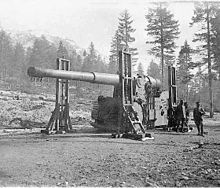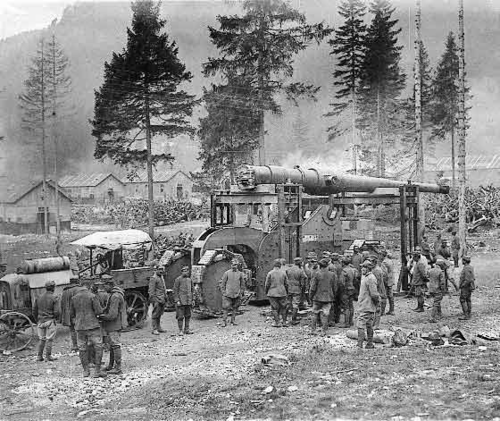gabrielorosco
I really should change my personal text
- Joined
- 10 December 2016
- Messages
- 194
- Reaction score
- 234
Hi to all,
Does anybody know what is the name of this Artillery Piece? Is it self propelled?
Thanks!


Wikipedia said:Italian Army use
As the First World War settled into Trench Warfare on the Italian Front the light field guns that the combatants went to war with were beginning to show their limitations when facing an enemy who was now dug into prepared alpine positions. Indirect fire, interdiction and counter-battery fire emphasized the importance of long-range heavy artillery. In order to address the Italian Army's lack of long range heavy artillery surplus 203/45, 254B, 254/40, 305/17, 305/40, and 305/46 Naval Guns were converted to land use.[19]
These guns were mounted on De Stefano carriages for land use and the resulting guns were classified by their size in millimeters 203, their length in calibers 45 and lastly by their carriage type DS which stood for De Stefano or 203/45 DS. The De Stefano carriage was a clever, but strange looking monstrosity which looked something like a large steel basket with the gun barrel mounted towards the rear of the carriage. The carriage was a large box-trail design with four non-steerable wheels. The wheels were fitted with detachable grousers designed by major Crispino Bonagente for traction on soft ground and was towed in one piece by a Pavesi-Tolotti artillery tractor.[19]
When not on the move the grousers were removed and the steel wheels rode on an inclined set of steel rails when in firing position. The steel rails were mounted on a firing platform made of wooden beams which allowed the gun 360°of traverse. When the gun fired recoil which was not absorbed by the recoil mechanism was transmitted to the wheels and the carriage rolled up the inclined rails and then rolled back into firing position. The box trail carriage was tall and wide enough that the breech of the gun was accessible at high angles of elevation without a pit being dug and the gun crew had a bucket and hoist for ammunition handling.
Thank you so much for your help a for the informations, my friend!!!Hi to all,
Does anybody know what is the name of this Artillery Piece? Is it self propelled?
Thanks!
I really should be working but...
It appears to be either an Italian 203/45 DS or 254/40 DS from WW1:-
View attachment 616893
View attachment 616894
203/45 Mod. 1897
EOC 8 inch 45 caliber
Not self-propelled, sorry.
Wikipedia said:Italian Army use
As the First World War settled into Trench Warfare on the Italian Front the light field guns that the combatants went to war with were beginning to show their limitations when facing an enemy who was now dug into prepared alpine positions. Indirect fire, interdiction and counter-battery fire emphasized the importance of long-range heavy artillery. In order to address the Italian Army's lack of long range heavy artillery surplus 203/45, 254B, 254/40, 305/17, 305/40, and 305/46 Naval Guns were converted to land use.[19]
These guns were mounted on De Stefano carriages for land use and the resulting guns were classified by their size in millimeters 203, their length in calibers 45 and lastly by their carriage type DS which stood for De Stefano or 203/45 DS. The De Stefano carriage was a clever, but strange looking monstrosity which looked something like a large steel basket with the gun barrel mounted towards the rear of the carriage. The carriage was a large box-trail design with four non-steerable wheels. The wheels were fitted with detachable grousers designed by major Crispino Bonagente for traction on soft ground and was towed in one piece by a Pavesi-Tolotti artillery tractor.[19]
When not on the move the grousers were removed and the steel wheels rode on an inclined set of steel rails when in firing position. The steel rails were mounted on a firing platform made of wooden beams which allowed the gun 360°of traverse. When the gun fired recoil which was not absorbed by the recoil mechanism was transmitted to the wheels and the carriage rolled up the inclined rails and then rolled back into firing position. The box trail carriage was tall and wide enough that the breech of the gun was accessible at high angles of elevation without a pit being dug and the gun crew had a bucket and hoist for ammunition handling.
